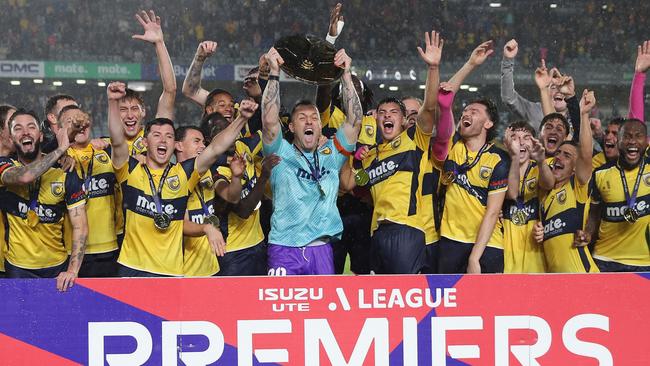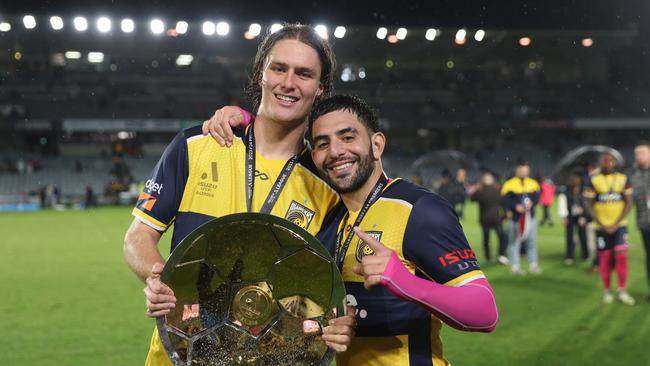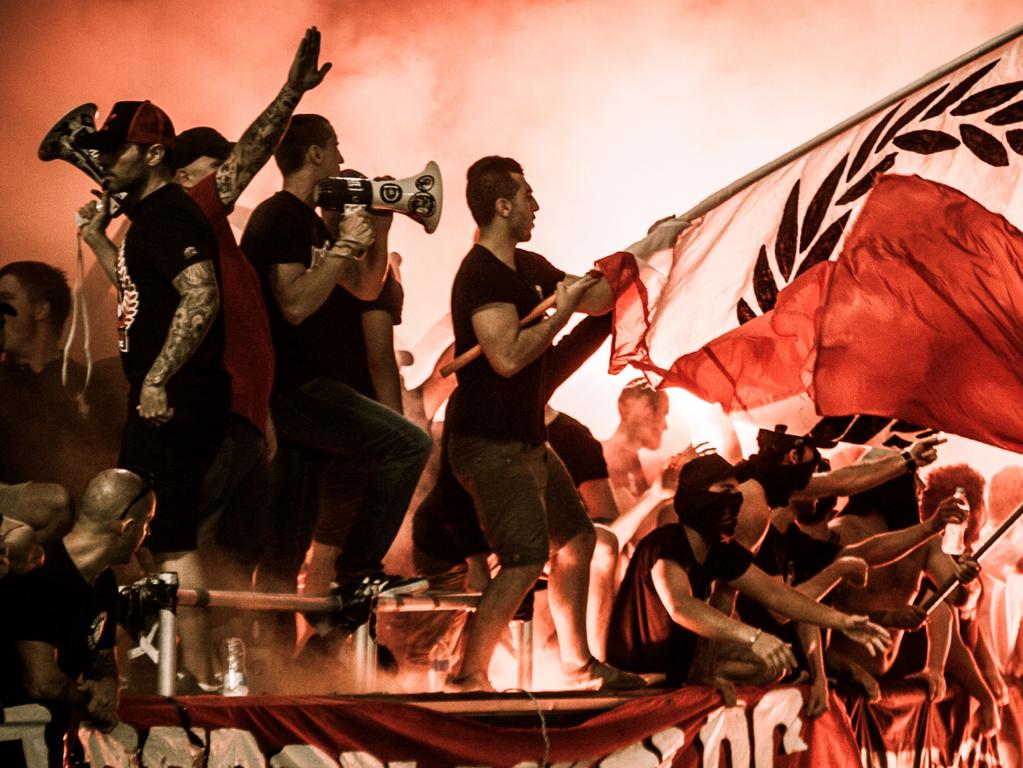Revealed: how the A-Leagues burnt through $140m
Australia’s premier footballing competitions have set fire to $140 million - how they did it can be revealed in detail for the first time.

It was the $140-million dream to propel the A-League into a new, financially healthy future built around data, marketing and digital content.
The A-League clubs would leverage that off-field success – tapping into football’s vast grassroots numbers and general fanbase – to on-field glory.
The clubs would control their own competition after splitting from governing body Football Australia at the end of 2020 and finally build it into something sustainable and successful.
In December 2021, the new Australian Professional Leagues organisation raised $140m from global private equity giant Silver Lake to turbocharge their dreams. But, shockingly, less than three years later that money is now all gone.
As Central Coast Mariners prepare to host Melbourne Victory on Saturday night in Gosford for the A-League men’s grand final, questions are being asked yet again about football’s financial future.
While governing body Football Australia surfs the success of the Matildas, the professional league – majority owned and controlled by the A-League clubs – is in a dire situation.
What has unfolded during the past two-and-half years is a cautionary tale involving a series of well-intentioned but ultimately risky spending initiatives that have backfired on the league and left observers and critics questioning where the money has gone.
An investigation by the Weekend Australian has pieced together details of the $140m that has been spent, including $35m outlaid on a digital and media business that has now mostly been abandoned.
There was also at least $40m spent to prop up the league and its clubs during and in the wake of Covid lockdowns and the tens of millions used in paying back loans and various marketing and promotional pursuits such as spending $1m on a new song and more on rebranding the A-League and women’s W-League to A-Leagues.

Back in late 2021, though, it was all looking rosy for the league as it excitedly announced the $140m deal with Silver Lake in exchange for a 33 per cent stake that valued the A-Leagues at an impressive $425m.
“This valuation recognises the latent potential that has long existed in the professional game in Australia, and the ability of our board and executive team to realise that potential,” A-Leagues chair at the time Paul Lederer, a billionaire, said.
Lederer and Simon Pearce, a powerful behind-the-scenes figure who also sits on the board of English Premier League powerhouse Manchester City – the Abu Dhabi majority owned-City Football Group owns Melbourne City and Pearce works for the Abu Dhabi government – were among the APL figures who oversaw the subsequent spending strategy of A-League chief executive Danny Townsend and his executive team.
The league had secured a $20m bridging loan from ANZ after it split from the governing body, helping tide it over before the Silver Lake funds came in.
It also needed to build a new commercial team, had no data or digital infrastructure, quickly find new sponsors and negotiate a new broadcast deal.
The league signed a $200m new five-year cash-and-contra broadcast deal with Network 10 and its streaming service Paramount and found new sponsors such as Isuzu and Liberty.
Silver Lake’s funds were crucial to the league’s growth, though, based around a strategy of growing by increasing its television audience, attendance and digital engagement with fans.
That growth strategy called for the capital to be deployed, with conditions, specifically to invest in marketing, content and data and digital infrastructure designed to finally attract all football’s participants to take an interest in the league.
The strategy was supported by clubs, with every item of major expenditure signed off by the APL’s risk and audit committee and the entire board – that included club, Silver Lake and Football Australia (which maintains a small stake) representatives.
Early on, bills that needed to be paid quickly soon began to eat into the $140m – even before the clubs got on to its strategy of reinvigorating a declining and fatigued league that was plateauing after almost 15 years of Football Australia control.
The $20m ANZ loan was paid back, sources say, and another $7m went to Football Australia as a condition of the league’s unbundling. American investment bank Raine received $7m for negotiating the Silver Lake deal.
Meanwhile, sports leagues in Australia and around the world were being smashed by Covid lockdowns. For the A-League, that meant delays to what would be a disrupted 2020-21 season after a truncated end to the previous competition, and then further travel restrictions and issues that also hit the 2021-22 season.
Wellington Phoenix would spend almost four seasons away from New Zealand due to border closures, much of it in Wollongong. Perth Glory would also face heavy state border restrictions and other club fixtures – and television broadcast production – also needed to be juggled.
About $20m, sources told The Weekend Australian, would eventually be spent housing Glory and Phoenix in NSW as well as travel and accommodation for other club movements and the paying of TV production when borders were shut and reopened at various times.
Covid would also smash the balance sheets of the 12 A-League clubs and the APL outlaid about $20m in additional club distributions to help shore up their financial situations. APL is understood to have made another $15m in loans to cash-strapped owners.
Covid would take its toll on Glory and its owner, mining entrepreneur Tony Sage, who would relinquish his A-League licence after 18 years of ownership in July last year. The APL has spent about $11m propping up Perth, and the club has since been sold to Melbourne property magnate Ross Pelligra for a token $1.

There has been about $5m spent on marketing initiatives such as the rebranding, but more contentious has been the $35m spent on the digital and media KeepUp business.
Townsend’s ambition was clear, as he told The Australian in mid-2021: “The digital product will be the biggest investment the game has ever made in itself. It is not just for A-League fans, it will be for football fans, participants, coaches, managers of grassroots clubs, members of A-League clubs, digital fans of other leagues around the world and so on.”
About $20m was spent building data and digital infrastructure, with about a dozen apps and websites built in nine months, and another $15m on content development, including journalists, video and social media producers and making documentaries and other football-specific online content.
The plan was to make KeepUp a one-stop shop of football content, including news, ticketing, video, and potentially even player registration. But Football Australia and state authorities have yet to connect its databases with that of the A-League, robbing the latter of a valuable source of fan information.
Critics have derided the KeepUp spend as a waste of money, while its supporters say a digital strategy is a must have if the sport was to ever grow.
But by the time Townsend left his role in late 2023, the writing was on the wall for KeepUp and new A-League management and newly installed independent chairman Stephen Conroy. The former Labor Senator made a majority of its staff redundant in January, taking what was described as a more “football-focused” approach.
Conroy would not comment when approached by The Weekend Australian this week.
The crisis has at least brought a new level of co-operation between the league and Football Australia, who had fought pitched battles as club owners battled for control.
A Football Australia insider said under the new leadership of Conroy and CEO Nick Garcia, the A-Leagues will be better placed to revive itself. “They have a back-to-basics approach, a football-first look rather than a digital approach they once had,” they said. “We are working well with them.”
They added: “The biggest thing we’ve done for the A-Leagues is the Women’s World Cup.”
As well as the $140m spend, the A-League has been hit by a string of other issues. It negotiated a $15m deal in late 2022 with the NSW government to shift A-League grand finals to that state, only to have to back down under fan pressure.
The Ten and Paramount deal has been problematic, to say the least. While the league had little competition for its rights when it went to market in 2021 after splitting from Foxtel, the deal was subject to performance-related Paramount subscriber clauses, which have not been met, which has seen Ten clawback money every season.
One source says Ten has paid as little as $22m in cash this season, while another source claimed the clawbacks have been negotiated back down to about $12m lost over the life of the contract.
One strategic misstep has been the A-League taking over its own broadcast production, which is said to have cost it about $17-18m per season, meaning it could be netting only about $5m in TV revenue annually.
The APL had been paying Global Advance Production to produce the games, but that company collapsed in March. Global Advance’s administrators claim the APL owes it $2m, which the APL is disputing.
Documents seen by The Weekend Australian show Global Advance’s management blaming the APL’s withholding of a $2m payment for the 2022 season’s broadcast for its eventual collapse. The APL had in January this year allegedly demanded Global Advance waive the $2m debt in return for a five-year contract extension.
Global later asked the APL for advances on that new contract and then collapsed after the APL refused, a creditor’s report claims. A-League sources strongly refuted the administrator’s claims that it could be to blame for Global’s collapse.
More recently, a betting scandal that emerged last week involving at least four players from Macarthur Bulls was another blow to the league.
Meanwhile, the league is still to clinch a deal with its clubs as to how much they will get from central distribution next season. It may be as little as $500,000 per club, which will require considerable additional cost-cutting.
With the $140m gone, the league continues to battle structural issues. Although it will receive an estimated $20m as a licence fee from new entrant Auckland FC, the APL is now trying to shrink its way to prosperity while also likely needing more funding from capital markets or other sources such as sponsorship before renegotiating a new broadcast deal in two years.
But who will put money into a competition that has already spent so much?
A long and hard salvage operation lies ahead for Conroy and the remaining APL executives.







To join the conversation, please log in. Don't have an account? Register
Join the conversation, you are commenting as Logout